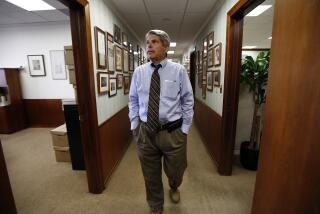Classroom and cathedral
Glaciers advance and retreat, but the joie d’esprit of John Muir is eternal. Anyone who today hikes the Sierra Nevada -- or, for that matter, their own special wild place -- is honoring Muir’s environmental activist legacy. To Muir, sequoias were God’s great spires, spruce groves all-season cathedrals and mountains his wayward home. Not only did Muir write with the poetic authority of Thoreau, but he also joined the U.S. Forestry Commission, offering practical land management. Besides writing the classics “Our National Parks” (1901) and “Travels in Alaska” (1915), he could play the wonk when necessary. No lover of California, in particular, had a way with words quite like Muir. After camping with Muir in Yosemite National Park in 1903, President Theodore Roosevelt fell under his spell. “John Muir talked even better than he wrote,” Roosevelt famously boasted. “His greatest influence was always upon those who were brought into personal contact with him.”
Reading Donald Worster’s superb new biography, “A Passion for Nature: The Life of John Muir,” is as close as history will ever get to understanding what made the multidimensional Sierra Club founder tick. Yosemite’s great bard bursts through Worster’s fine prose in all his cosmic grace and preservationist pluck. The Hall Distinguished Professor of American History at the University of Kansas, Worster is perhaps best known for his Bancroft Prize-winning “Dust Bowl: The Southern Plains in the 1930s” (1979) and, more recently, a hefty biography (probably definitive) of John Wesley Powell. But to thousands of doctoral students (former and current) he is the grand pooh-bah who launched environmental history as a field of serious academic pursuit in the 1970s. For decades now, Worster’s keen insights into the American West’s curse of aridity have been model studies of both cutting-edge historiography and sound contemporary living advice. In “The Wealth of Nature” (1993) and “A River Running West” (2001) Worster repressed his more mystic inclinations in favor of scholarly detachment. Academics often feel clumsy in the world of adjectives, but Worster isn’t this time:
“Through knowing John Muir better, we can see how the modern love of nature began as an integral part of the great modern movement toward freedom and social equality, which has led to the pulling down of so many oppressive hierarchies that once plagued the world. We come to realize that fighting to save the great whales, the tropical rain forests, or even a single acre of prairie has been a logical outcome of that movement, along with all efforts to decrease the human footprint on the planet to use resources more justly and responsibly, and to achieve a greener society.”
Muir was born in Dunbar, Scotland, on April 21, 1838. His father was abusive. In his memoir “The Story of My Boyhood and Youth,” Muir claimed that his outdoors preference emanated from a “natural inherited wildness in our blood.” At 11, he emigrated with his family from Glasgow to Wisconsin. Throughout his adolescent years he toiled on his father’s farm and tinkered with building clocks, barometers and hydrometers. During the Civil War he enrolled at the University of Wisconsin-Madison, inventing a student desk clock that retrieved a book, held it stationary for hours, then automatically replaced it with a different volume. (The illustration from the Wisconsin Historical Society confirms Muir drew one mega-weird contraption.) Muir also devoured the works of Robert Burns and Walt Whitman. The great seer Ralph Waldo Emerson, in fact, who encountered Muir in his dotage, deemed him as “one of my men,” a true-blue Transcendentalist through and through.
Over time botany developed into Muir’s true passion. In 1863, he took his first botanical tramp along the Wisconsin River to the upper Mississippi River. Hunting for plants liberated him from religious orthodoxy and family commitment. He drifted up to Ontario, Canada, working for a long spell at a sawmill and broom-rake factory. While in Ontario, he discovered the rare orchid Calypso borealis (this led to his first published article in the Boston Recorder). Odd jobs became Muir’s specialty: It was his way to finance romps.
In 1867, however, a factory accident caused Muir temporary blindness. When his vision returned, Muir made a pact with himself to dedicate his life to nature (“the University of the Wilderness,” as he called it). Off he went on a 1,000-mile walk to the Gulf of Mexico and Florida (with Cuba and South America his ultimate destinations). Although a bout of fever disabled him from tramping south of the Tropic of Cancer, Muir contemplated the relationship between man and nature in profound new ways while his temperature soared and health deteriorated. Not until 1911, as Worster writes, would Muir fulfill his dream of exploring the Amazon.
It was Muir’s arrival in San Francisco in 1868 that forever changed his life; from April to June he hiked around Yosemite. Walled in by range upon range of the Sierra Nevada, Muir was captivated by the enduring rocks, slow-moving glaciers and redwoods that Yosemite offered in astonishing numbers. There was a grace to Yosemite that defied language; it was a terrestrial manifestation of the Almighty: As Muir wrote to a friend in 1871, “Yosemite is the end of a grand chapter -- if you learn to read it -- go commence at the beginning. . . . The grandeur of these forces, of their glorious results overpower me and inhabit my whole being, waking or sleeping I have no rest.”
From the 1870s onward, Muir’s mystic-like life was framed by Yosemite benchmarks: first, his ascent of Cathedral Peak; taking Emerson to see the waterfalls; publishing his first California article on glaciers; and promoting the wilderness protection ethos in Century magazine. He began sneering at sheepherders whose overgrazing was destroying magnificent valleys. In between there were all sorts of fine adventures ranging from climbing Mt. Shasta (more than 14,100 feet) to floating down the Chico River. But somehow it always got back to holy Yosemite. Muir’s discoveries in Alaska, promotion of U.S. national parks and creation of the Sierra Club brought him heaps of celebrity back East. He became wild California personified to the New York literary set. When Muir published his first book in 1894, “The Mountains of California,” he became widely known as the Sage of the Sierras, the West Coast version of John Burroughs. The California naturalist, in fact, wrote so much high-quality prose that Worster employs the term “Muirian” in his endnotes to describe what’s become a cottage industry.
A marvelous father and husband, albeit a globe-trotting one, Muir always had folk wisdom to share with everybody. Unlike Roosevelt, for example, who believed that hunting and fishing provided “ideal training for manhood” and would “save the nation” from effeminacy, Muir scoffed at such “Strenuous Life” appeals. Famously he asked Roosevelt (whom he loved as an outdoors companion), “When are you going to get beyond the boyishness of killing things? . . . Are you not getting far enough along to leave that off?” And Muir wasn’t merely tweaking the president for his big-game hunting penchant. His dissent was pure. According to Worster, when Muir received a solicitation of support from a Boy Scout-like society called the Sons of Daniel Boone, he politely deferred. Young Americans, Muir wrote back, needed to abandon “natural hunting, blood-loving savagery into natural sympathy with all our fellow mortals -- plants and animals as well as men.”
Appropriately the last chapters of “A Passion for Nature” deal with Hetch Hetchy -- the glacial valley filled by the Tuolumne River in 1923 with the construction of the O’Shaughnessy Dam. What a sad tragedy! The destruction of Hetch Hetchy -- once an integral part of Yosemite National Park -- was flooded for what Muir called “mean commercialism.” The principal villain of the sordid act was ex-San Francisco Mayor James Phelan, a first-rate greedy scoundrel. The Hetch Hetchy saga involved three U.S. presidents, their roles all recounted by Worster with admirable drama. The Muir quoted in “A Passion for Nature” over the reservoir fight sounds like an Old Testament prophet, shaking his angry fists at “robbers of every degree from Satan to Senators.”
Muir may have lost the Hetch Hetchy fight, but his battlefield-style methods have won over millions to the modern environmental movement -- particularly through the terrific ongoing work of the Sierra Club. The very thought of a tireless Muir inspires citizens to stand up to the blind infidels of offshore oil-drilling, thoughtless timbering and unnecessary irrigation projects. One hundred years ago the call was to save Hetch Hetchy. Today it is to protect Alaska’s ANWR from corporate exploitation and defiling. Luckily, for us, the guiding hand of Muir remains, urging society onward with an 11th Commandment: Thou shalt not mar unnecessarily.
More to Read
Sign up for our Book Club newsletter
Get the latest news, events and more from the Los Angeles Times Book Club, and help us get L.A. reading and talking.
You may occasionally receive promotional content from the Los Angeles Times.






